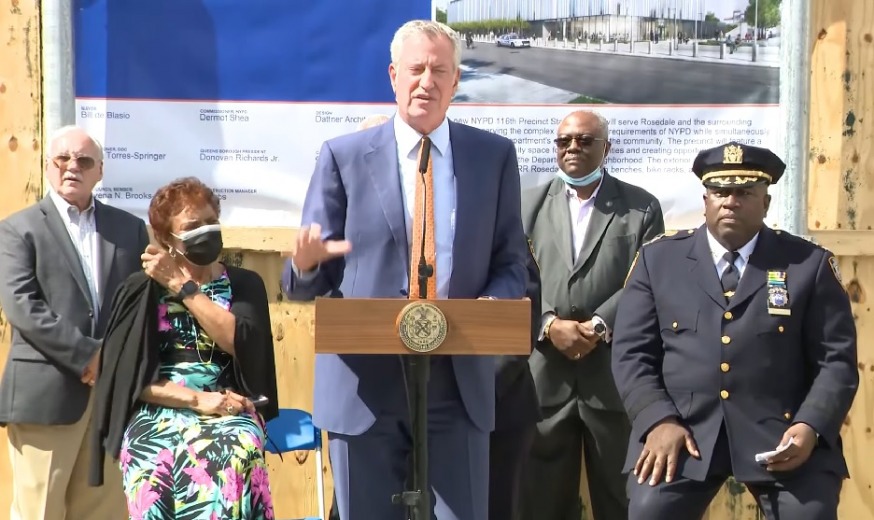
City officials broke ground Monday on a new stationhouse in Rosedale that will anchor the newly-formed 116th Precinct in southeast Queens. (Photo: screenshot)
Sept. 21, 2021 By Christian Murray
The city has broken ground on a new NYPD stationhouse in Rosedale and officials were on hand Monday to celebrate the occasion.
The stationhouse is going up at 242-40 North Conduit Ave. and will anchor a new precinct—to be called the 116th Precinct—that will serve Rosedale, Laurelton, Springfield Gardens and Floral Park. These neighborhoods have been patrolled by the 105th Precinct that is based in Queens Village.
“Southeast Queens fought hard to make this day possible, and this neighborhood deserves responsive, community-centered policing,” said Mayor Bill de Blasio who was at the groundbreaking.
The 116th Precinct will cover a significant portion of territory currently patrolled by the 105th Precinct
The 105th Precinct is presently the fifth largest precinct in the city, covering 12.5 square miles and 354 miles of roadway in southeast Queens. The primary goal of the new precinct—which will take over the southern portion of the 105th Precinct—is to reduce response times.
The new stationhouse, according to officials, has been placed strategically within the community to allow for more rapid responses.
Construction on the $78 million building began last month and is projected to be completed in January 2024.
The station will be a 48,410 square foot facility and will come with a community meeting room where residents are able to engage with officers in order to strengthen community policing.
“The groundbreaking for the new 116th Precinct is a historic moment, decades in the making, and was only possible due to the relentless and committed advocacy of local residents and community organizations,” said Council Member Adrienne Adams. “This precinct will cut response times for residents, provide more resources for public safety, and improve police-community relations.”
Queens Borough President Donovan Richards, who advocated for the new precinct while he represented the district in the city council, said: “I proudly secured funds to make this precinct a reality, and I am thrilled to see it is a new day in Southeast Queens.”
The plan for the new precinct was almost upended in 2020, despite receiving city approval in 2017.
The funding for the precinct was yanked when the city slashed the NYPD budget. The funds for the precinct were reallocated for a community center in Roy Wilkins Park in St. Albans, among other uses.
However, the budget for the project was restored by the mayor in April, when he noted a stronger fiscal outlook for the city. De Blasio also said that community leaders wanted the precinct and the neighborhood deserves responsive community-centered policing.
The 116th precinct will be the first new precinct established in New York City since 2013.
“This new police precinct was conceived by the communities of Southeast Queens,” said Police Commissioner Dermot Shea in a statement. “It was forged, and designed, as a reflection of their best vision for effective public safety and is thankfully now being realized after decades of their hard work and inspiration.”
